Mannar’s donkey buddies
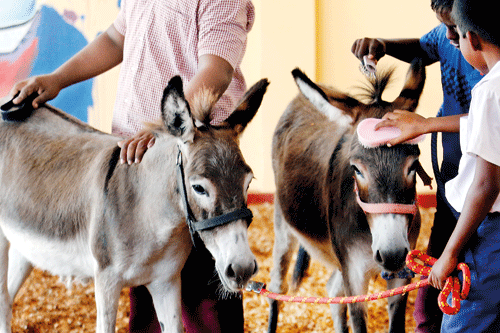
Time for grooming at the DAT Centre. Pix by M.A. Pushpa Kumara
Saya, Maria, Evelyn and ‘baby’ Alex……all are “hits” with anyone who crosses their paths.
Even though they and their ‘kith and kin’ have been around for a long time in Mannar, it is very recently that the interactions and bonding began in earnest.
It is this bonding, between human and animal — special children and donkeys — that we see during a recent visit to the first-ever Donkey-Assisted Therapy (DAT) Centre in the whole of South Asia, established in Murunkan, Mannar.
Evelyn the ‘black beauty’ is the favourite of 13-year-old Jesudas Jeya Emoriyan who gets to groom, feed, lead and play with her as well as her foal, Alex. “We have seen a marked change in him,” smiles his Appa, Nadarasa Jesudas, explaining that there is a new vigour in him and yearning to interact with his donkey-buddies, rather than the twice-weekly meetings.
The DAT Centre initiated by Bridging Lanka headed by Jeremy Liyanage under its wider effort of the ‘Mannar Donkey Management and Welfare Programme’ is ably supported by Coordinator Kelvin Fernando and Manager Sebastianpillai James Jesuthasan at ground level.
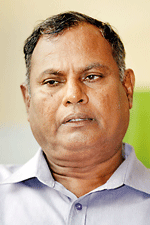
James Jesuthasan
Working in tandem with the Mannar Association for the Rehabilitation of Differently-Able People (MARDAP) established by the Holy Family Sisters, with its Patron being Bishop Emeritus Dr. Rayappu Joseph, the DAT Centre is endeavouring to provide life-skill therapies.
“Such bonding through riding, grooming and befriending the donkeys, helps the children, stimulating their development,” says Jeremy.
The ‘trot’ into the establishment of the DAT Centre was nudged after a visit to Mannar by Dr. Ramesh Kumar of the Donkey Sanctuary of India modelled on the one in the United Kingdom. Starting small, about two years ago, Bridging Lanka has now expanded the therapy programme by constructing the DAT Centre buildings on MARDAP land.
These 10 children from Murunkan and 20 from Mannar, some of whom are autistic, have severe hearing and speech impairments, Down’s Syndrome or learning disabilities, tenderly hand-feed, groom and also talk to these donkeys, reiterates Kelvin, referring to the life-skills of empathy, self-awareness and confidence, communication through eye-contact, critical thinking and problem-solving and also team work that they are in the process of learning.
From 9.30 to 11.30 a.m. every Monday and Tuesday, the three donkeys and foal become their protégés, with Emoriyan, who has had 12 sessions and more being a good example. Smilingly, he poses for photographs without hesitation and it is obvious that he yearns to be with his pets, the donkeys, like most children would with their cats or dogs. The “sinna” one, Alex, is Emoriyan’s beloved.
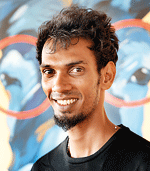
Kelvin Fernando
In the first session, 15-year-old Livingstone did not venture beyond the gate of the DAT Centre, fearful of getting close to the animals but that challenge he has overcome. The reaction of 10-year-old Gnanaseelan Thuyavan was also the same initially but now he is completely at ease with the donkeys, keen to touch them, with his parents observing a “great change” in his behaviour at home.
Flipping back the pages of time, Kelvin says that the donkeys and the Mannar district, comprising the mainland and the island, have been inextricably linked for centuries. Currently, the population is 106,000, while the last Census records about 1,200 donkeys, with about 375 living in urban areas and 90% on the island.
Before the start of the 30-year conflict, some of the donkeys had been domesticated and were owned by people, particularly the dhobis who used them to carry bundles of clothing, says Kelvin, adding that, however, during the war many migrated to other areas, abandoning their donkeys.
“Gradually, people began hating the donkeys, for they would run around fast causing motorcycle and bicycle accidents. One or two elderly people got killed after falling on the road due to the erratic behaviour of the donkeys,” says James.
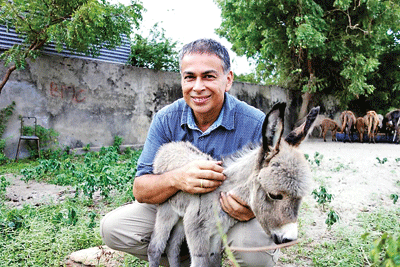
Jeremy Liyanage
Still not sure from where the donkeys are from originally, Kelvin has read that Arab traders brought them a long time ago, while James thinks that they are from Somalia. He believes that after the donkeys, camels were brought along with baobabs which were their food, but the camels did not survive, while the baobabs took root and the trees did and so did the donkeys.
Kelvin groups the donkeys into urban donkeys which have become strays but are accustomed to living with people and feral donkeys, the wild ones, which flee when approached by humans.
Next he dwells on the “good” things that the people of Mannar believe about donkeys – how donkey milk and human milk are similar; how cheese made of donkey milk is very expensive; how donkey blood has much medicinal value and is administered to alcoholics to rid them of their addiction; how donkey blood wards off the evil-eye; how the braying of donkeys keeps the coconut beetle at bay; and how the smoke from burning donkey-dung keeps away mosquitoes.
Unfortunately, though, donkeys are also associated with lower castes and that is the mindset that Bridging Lanka is attempting to change through school and community awareness programmes by raising the profile of donkeys.
| A sanctuary for both people and animals | |
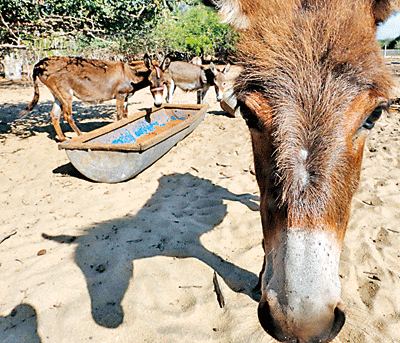 Donkey Clinic and Sanctuary: Haven for battered and bruised donkeys Many-pronged is Bridging Lanka’s ‘Mannar Donkey Management and Welfare Programme’, with a major component being the Donkey Clinic & Sanctuary where 15 animals have already found shelter and solace. “Most of the donkeys in the urban areas are ill or injured, some even crippled, having serious injuries such as broken legs and festering sores due to the human-donkey conflict. Sometimes these donkeys also starve and are forced to feed on polythene, while some veterinarians are not too familiar on how to treat donkeys, as they are found only in Mannar and Kalpitiya,” says Kelvin. The clinic is integral to animal welfare, points out Jeremy, explaining that the protection of these animals needs to be connected to economics. This is why the Donkey Clinic and Sanctuary is sprawled across two acres in the impoverished village of Thailankudiyiruppu and the aim is to ease the unemployment challenges faced by the widows there. It is also a tiny ‘reconciliation’ model, with the land on which it has been set up having belonged to a Muslim, while the workers are Catholics, Hindus and Muslims. The new use of donkeys that Bridging Lanka is exploring includes tourism promotion through donkey-specific tours. Jeremy had got thinking on these lines when in 2009 he visited Mannar after a ‘Business for Peace Conference’ held in Colombo which was followed by a visit to the south by some participants and to Mannar by others. With the words of the Mannar Chamber of Commerce Chairman, “No one comes to Mannar”, ringing in his ears, in 2010 Jeremy decided to gently guide some of his friends from Australia to this starkly beautiful area. The other donkey-focused efforts include: Donkey Feeding Stations – Collection of throw-away vegetables from vendors and distribution among households which have agreed to help out. While this feeding programme draws the donkeys away from the town centre where there is conflict with humans, the families which provide food and water are able to tame and befriend the donkeys. Capacity-building of veterinary staff – With little being known about the treatment and care of donkeys, regular workshops and clinics are being conducted by veterinary surgeons from around the world for those in the Departments of Wildlife Conservation and Animal Production & Health and animal welfare agencies. |


